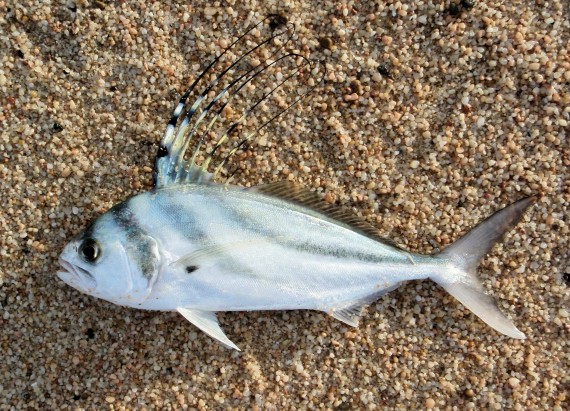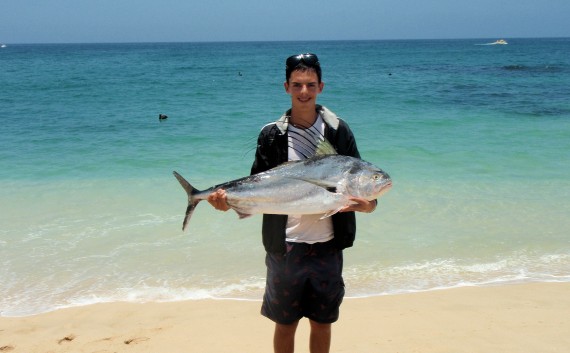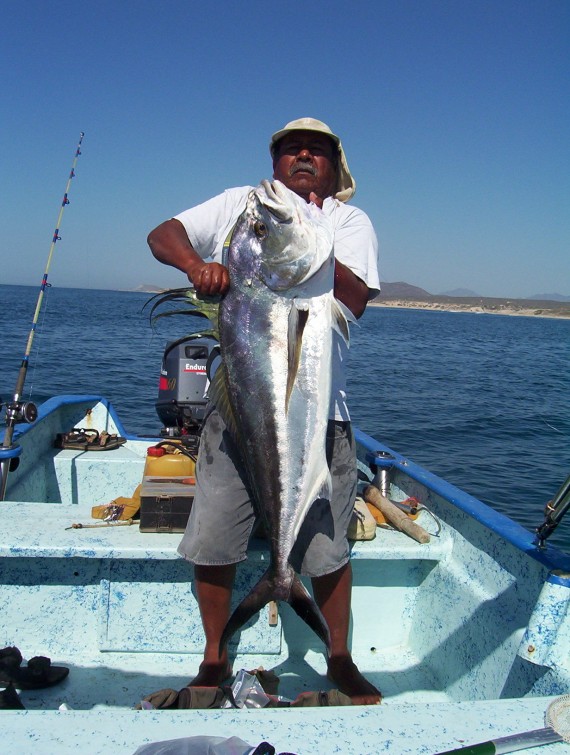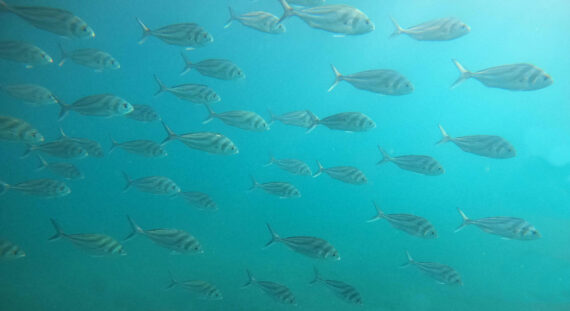Roosterfish, Nematistius pectoralis
 Roosterfish, Nematistius pectoralis, Juvenile. Fish caught off the beach at Km 24, Cerro Colorado, June 2009. Length: 36 cm (14 inches).
Roosterfish, Nematistius pectoralis, Juvenile. Fish caught off the beach at Km 24, Cerro Colorado, June 2009. Length: 36 cm (14 inches).
 Roosterfish, Nematistius pectoralis. Fish caught from coastal waters off Point Palmilla, Baja California Sur, July 2009. Length: 95 cm (3 feet 1 inches). Weight: 10 kg (22 lbs). Catch courtesy of Eduardo Correa, Mexico City, Mexico.
Roosterfish, Nematistius pectoralis. Fish caught from coastal waters off Point Palmilla, Baja California Sur, July 2009. Length: 95 cm (3 feet 1 inches). Weight: 10 kg (22 lbs). Catch courtesy of Eduardo Correa, Mexico City, Mexico.
 Roosterfish, Nematistius pectoralis. Fish caught from coastal waters off Puerto Los Cabos, Baja California Sur, August 2004. Length: 1.26 m (4 feet 2 inches). Weight: 24 kg (53 lbs).
Roosterfish, Nematistius pectoralis. Fish caught from coastal waters off Puerto Los Cabos, Baja California Sur, August 2004. Length: 1.26 m (4 feet 2 inches). Weight: 24 kg (53 lbs).
 Roosterfish, Nematistius pectoralis. Underwater photograph taken in coastal waters off Loreto, Baja California Sur, October 2024. Photograph courtesy of Bob Hillis, Ivins, Utah.
Roosterfish, Nematistius pectoralis. Underwater photograph taken in coastal waters off Loreto, Baja California Sur, October 2024. Photograph courtesy of Bob Hillis, Ivins, Utah.
The Roosterfish, Nematistius pectoralis, is one of the true exotics of the world, that is a member of the Roosterfish or Nematistiidae Family, and known in Mexico as papagallo and pez gallo. It is only this species in the genus Nematistius, and it is found in Mexican waters of the Pacific Ocean.
The Roosterfish has an elongated compressed body that are bluish gray in color with silvery reflections. They have 4 dark bars, one between their eyes, one across the rear part of their head, 2 obliquely curved black bands on their sides, one of which extends down the center of the caudal base. Their head is pointed and features simple teeth. Their anal fin has a much shorter base than the dorsal fin and has 2 spines and 15 rays; their caudal fin is deeply forked; their first dorsal fin has 7 spines the last 6 of which are very elongated and filamentous; the second dorsal fin has 1 spine and 25 rays; and, their pectoral fins have 16 rays and are long and curved being longer than their pelvic fins. They are covered with small scales.
The Roosterfish is a schooling species found along sandy shores at depths up to 18 m (60 feet). They can reach up to 1.91 meters (6 feet 3 inches) in length. As of January 1, 2024, the International Game Fish Association world record for length stood at 1.36 m (4 feet 6 inches) with the fish caught from coastal waters off Panama in December 2019. The corresponding world record for weight stood at 51.7 kg (114 lbs 0 oz) with the fish caught in coastal waters off La Paz, Baja California Sur in June 1960. A Roosterfish Weight from Length Conversion Table has been included in this website to allow the accurate determination of a fish weight and a return to the ocean unharmed. They are voracious ambush predators feeding on small fish that include a variety of long slender fish (ladyfish, mullets, halfbeaks, and herrings) and have been known to swallow a 51 cm (20 inches) ladyfish whole. The Roosterfish is poorly studied with very limited information available about their lifestyle and behavioral patterns including specific details on age, growth, longevity, movement patterns, diet, habitat use, and reproduction.
The Roosterfish is a resident of all Mexican waters of the Pacific Ocean with the exception that they are absent from the extreme northern portions of the Sea of Cortez.
The Roosterfish is an easy fish to identify due to its unique “rooster comb” and thus cannot be confused with any other species.
From a conservation perspective the Roosterfish has not been formally evaluated. They are a targeted species of recreational anglers as they are exceedingly strong and can make long runs. They can be caught via trolling live bait within a quarter mile of the beach or on live bait, or Ranger Plugs and Klassen Poppers off the beach. They are a seasonal species that follow mullet and are found in the greater Los Cabos area primarily during the months of May, June, and July. The Roosterfish is not a favorite of local fishermen and considered to be an incidental catch. The smaller ones are retained for human consumption but overall they are a poor food fish but are available on occasion sold “fresh” in local markets in the greater Los Cabos area to the uninformed.